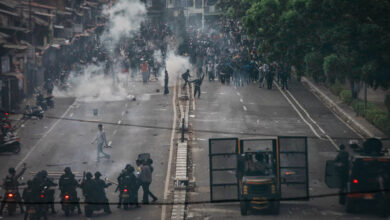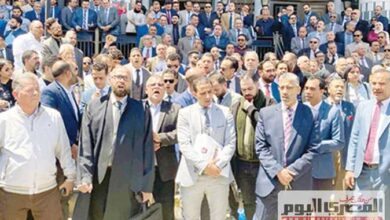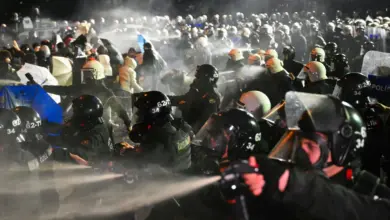Go to any protest outside Tahrir Square today and you will inevitably hear onlookers grumbling about “April 6 youths destroying the country” — even when the group has no presence at the demonstration.
The April 6 Youth Movement’s reputation doesn’t so much precede it as outstrip it. Loyalists of former President Hosni Mubarak vilify the group’s leaders as foreign-funded traitors intent on (and more to the point, capable of) using their cadres to destroy Egypt as part of a vaguely-worded plot usually involving a foreign Western power.
The group inspires the particular ire of the “I Am Sorry, Mr President” Facebook group made up of Mubarak sympathizers. It dedicates large swathes of its Facebook wall to mobilizing its members against its nemesis through a torrent of accusations and insinuations, and together the groups form a sort of Yin and Yang of Facebook activism relying on the same medium to achieve very different ends.
The group can be positioned in the landscape of emerging youth groups since the mid-2000s, which operated outside the scope of formal political parties and were at the forefront of street politics, all while without clearly articulated political propositions.
Before the revolts
The legend of the April 6 Youth Movement’s creation is well known: the Facebook invitation by activists Ahmed Maher and Esraa Abdel-Fatah for a national general strike in solidarity with a strike planned by textile workers in the Delta town of Mahalla on 6 April 2008; the thousands of Facebook users who responded to it; the clashes in Mahalla and the video of protesters tearing down a poster of Mubarak before beating it with their shoes.
And then, nothing significant in the three years between the group’s founding and the 25 January revolution.
April 6 member Mohamed Adel says that the group has gone through three incarnations since its establishment, going from a group lobbying for political reforms to a “youth resistance movement with a street presence” and finally “direct confrontation” with the regime.
It is difficult to identify clear demarcations between these three phases, however. In addition to its online presence, April 6’s main activity has always been protests, the majority of which are in reaction to events. The group picked up where opposition group Kefaya left off by taking to the streets, but was never able to attract anything near the numbers that Kefaya mobilized in 2005, according to observers.
In the lonely days of late 2008 and 2009, when street politics waned significantly due to intensified repression by the Mubarak regime, many April 6 protests were attended by only a handful of demonstrators (group members themselves). Many of these demonstrations were called to demand the release of an April 6 member detained during a previous protest. Nevertheless, they raised their voices in a largely silent period.
"[6 April] were useful in street protests in the same way bloggers were useful in 2005 [during the democracy movement spearheaded by the Kefaya opposition group] because they were a group that started something, and other people joined them. They were a unified bloc on the streets, they were a presence," says activist Amr Gharbeia.
Beyond the street activism and the opposition of the ancien regime, many questions loom around the politics of the April 6 Youth Movement.
Both Maher and Adel were members of the Youth for Change movement, Kefaya’s youth wing. Adel was a tender 16 (he is now 23) when he began his activism.
Young people were attracted to April 6, Adel says, because, “at that time political parties were useless and played no role at all. Young people preferred to join a group that planned some kind of activity every day and which, like the young person himself, was non-ideological.”
In fact, the group experienced the first of two splits in its history in 2009 over differences about whether the group should remain non-ideological, although the splinter group that came out of this separation has since disintegrated.
Activist and Professor of Political Science at the American University in Cairo Rabab al-Mahdi contests the extent to which April 6 can be categorized as non-ideological.
“You can call yourself post-ideological as much as you want but at the end of the day the policies you’re for and the policies you’re against actually categorize you,” Mahdi says.
“So they might not recognize it or advertise it, [but] their positions on issues make them ideological in a certain way. You cannot over-emphasize the anti-ideology and then say I’m against Mubarak. This is an ideological position.”
A good example however of April 6’s non-ideological approach is perhaps provided by their support of Mohamed ElBaradei’s short-lived bid for presidency.
April 6’s support for ElBaradei was as an “alternative,” Adel says, rather than a statement of political affiliation, explaining that ElBaradei represented a “new kind of pressure on Mubarak” and that the group “didn’t regard him as a savior” but as a “tool” they could make use of.
“We started encouraging people to be active in working-class areas, rather than only staging protests outside the Journalists Syndicate. We also collected signatures on the National Front for Change’s petition of six demands. People responded,” Adel says.
ElBaradei’s return to Egypt and the movement for change he initiated in 2010 coincided with a host of significant events in that year.
The New Year’s Eve Two Saints Church bombing in January 2011 in Alexandria followed the fatal beating of Khaled Said by two policemen in July 2010, which stirred a series of anti-torture protests. In October 2010, parliamentary elections witnessed the usual low voter turnout and violations by the National Democratic Party.
The overthrow of Tunisian dictator Zine al-Abidine Ben Ali in January 2011 translated these mounting frustrations into action, Adel suggests, adding that April 6 had been preparing for their annual “celebration” of National Police Day on 25 January since late 2010.
They began coordinating with Wael Ghonim and Abdel-Rahman Mansour, the administrators of the We Are All Khaled Said Facebook page, which amassed a viral following, and mobilizing for 25 January — exactly as they are doing now.
The revolutionary aftermath
A year after the revolution, what role is there for April 6?
Maher says that April 6 will monitor Parliament’s performance and “confront any mistakes.” The general coordinator adds that the group will “continue to mobilize in Tahrir Square” when necessary.
Adel lists April 6’s current priorities as “building a new state, societal reform and putting pressure on anyone in power.”
The group is currently pursuing two initiatives. Ekteb dustorak (“Write Your Constitution”) began life as “No to a Constitution under Military Rule,” but the name was changed, April 6 member Amal Sharaf says, when the group realized the inevitability of the constitution being written under military rule with the extension of the generals’ transitory ruling mandate.
Sharaf says that the campaign, which aims at producing a draft constitution written by the public, has reached “most governorates” despite initial obstacles.
People were suspicious of a campaign by April 6, “whose name the Supreme Council of the Armed Forces is constantly tarnishing” Sharaf says. In July of last year, the SCAF issued a statement accusing April 6 youth of creating strife between people and the armed forces.
In addition to being subjected to verbal insults and physical attack, the group also faced the arguably bigger hurdle of there being little public interest in the initiative.
This changed subsequently, Sharaf says, when people “despaired” about the SCAF and the People’s Assembly, “which hasn’t done anything and is full of Salafis and Muslim Brotherhood members who want to control everything, even the constitution.”
A second campaign, “Ana Abreely” (“I am April 6”) is a response to the defamation campaign Sharaf says the SCAF launched against the group. April 6 members have taken to the streets to correct public misperceptions about the group and its founders.
“Our tools and resources are extremely limited compared with the SCAF’s but we’re trying and the reaction has been positive. Lots of people have welcomed the initiative and thank us for our efforts,” Sharaf says.
What lies ahead is harder than what has already been achieved, Adel says.
“April 6’s objective was always to remove Mubarak and build a state. We knew that Mubarak was only the beginning, and that the fight would continue after that. Realizing an alliance, or consensus, between the Muslim Brotherhood and liberals is a million times harder than removing Mubarak,” Adel said.
“The battle with the People’s Assembly will be a new type of fight — before we were doing battle with oppressors, then the military, now we’re dealing with civilians in an elected body. It will be harder, especially since this is the first time and we have to deal with the Muslim Brotherhood, a large bloc.”
But in order to engage in this new battle, the group needs to articulate a different political offering, pundits say.
Mahdi suggests that to increase its membership April 6 needs to “look beyond the youth model and start providing clear political alternatives.”
“Until now, April 6 has identified itself against the others — they know what they don’t want but they don’t know what they want, so it’s been reactive. What they need to do now is be proactive by providing a political alternative or working for a political alternative,” Mahdi says.
“Just saying I’m for the revolution doesn’t provide people with a way forward … Okay, I’m for the revolution, what do you want me to do? Where is the revolution taking us? This is something that April 6 so far has not been able to provide.”




